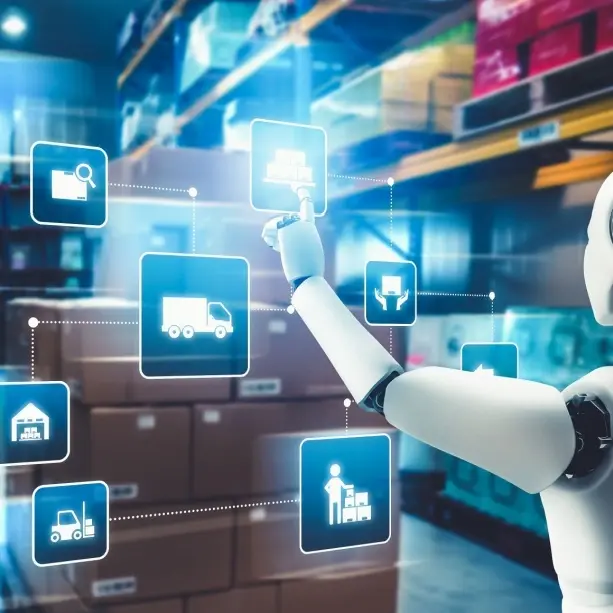As a technology, AI is rapidly gaining prevalence across both consumer and commercial spaces. It’s only natural, then, that more and more industries are looking for ways to employ AI within their operations in order to stay competitive and see continuing results. One of the areas that AI can be used to improve is within the supply chain. While there is no one best way to employ this technology, by combining AI to address any number of the following challenges, you can rest assured that you are getting the most out of your investment.
Increase Your ROI by Investing in AirFinder Everywhere
- Loss Prevention. Reduce the amount of loss that occurs during the supply chain process
- Location Coverage. AirFinder Everywhere uses a combination of GPS, Cellular, and WiFi to determine location everywhere
- Security Alerts. Know when a delay in shipment has occurred so the problem
can be addressed immediately.
1) Demand Forecasting
Predictive analytics, powered by AI, allows businesses to forecast future demand with remarkable accuracy. By analyzing historical data and identifying patterns, AI can predict market trends, seasonal demands, and customer preferences. This foresight enables companies to prepare adequately, ensuring that supply meets demand without excessive surplus or shortage. Traditional forecasting methods often fall short due to their reliance on static models and limited data. AI, however, continuously learns and adapts from new data, refining its predictions over time. This dynamic approach significantly reduces forecasting errors, allowing businesses to allocate resources more effectively and minimize wastage. With precise demand forecasts, businesses can optimize their inventory levels. AI helps in maintaining the right balance of stock, avoiding the pitfalls of overstocking and stockouts. This optimization not only reduces holding costs but also ensures that products are available when customers need them, enhancing satisfaction and loyalty.
2) Supply Chain Planning
AI aids in the strategic planning of supply chain operations by simulating various scenarios and analyzing their potential outcomes. This capability allows businesses to develop robust strategies that account for uncertainties and disruptions, ensuring continuity and efficiency in their supply chains. Supply chains are dynamic, with conditions changing rapidly. Using AI at the edge enables real-time adjustments by continuously monitoring data and suggesting immediate actions. Whether it’s rerouting shipments due to weather disruptions or adjusting inventory based on sudden demand spikes, AI ensures that the supply chain remains agile and responsive. AI also fosters enhanced collaboration among supply chain partners by providing a unified platform for data sharing and communication. This transparency ensures that all stakeholders are on the same page, facilitating coordinated efforts and reducing the risk of miscommunications and delays.
3) Inventory Management
AI-powered systems can automate the stock replenishment process by monitoring inventory levels and predicting future needs. This automation ensures that stock is reordered at the optimal time, preventing both overstocking and stockouts. It streamlines operations and reduces the burden on human resources. Real-time inventory tracking enabled by AI operates by providing businesses with up-to-the-minute information about stock levels, locations, and movements. This visibility helps in making informed decisions, optimizing storage, and improving order fulfillment rates. It also aids in identifying and addressing discrepancies swiftly. By continuously analyzing sales data, market trends, and supply chain performance, AI minimizes the risks of stockouts and overstocks. It ensures that inventory levels are always aligned with actual demand, reducing the costs associated with excess inventory and lost sales due to unavailability of products.
4) Logistics and Transportation
AI provides assistance for the logistics and transportation aspect of supply chains in multiple ways. Firstly, AI enhances route optimization by analyzing traffic patterns, weather conditions, and delivery schedules. This analysis helps in determining the most efficient routes for transportation, reducing travel time and fuel consumption. It ensures timely deliveries and reduces operational costs. AI in fleet management also involves monitoring the condition and performance of vehicles. Predictive maintenance powered by AI can foresee potential issues before they become critical, ensuring that the fleet remains in optimal condition. This proactive approach minimizes downtime and extends the lifespan of vehicles. Finally, AI contributes to reducing transportation costs through efficient route planning, optimal load distribution, and timely maintenance. By maximizing the use of resources and minimizing wastage, AI ensures that logistics operations are cost-effective and sustainable.
5) Warehouse Management
AI-driven automation in warehouses involves the use of robots and automated systems for various tasks such as sorting, picking, and packing. This automation increases speed, accuracy, and efficiency, reducing the reliance on manual labor and the risk of human error. AI also enhances the picking and packing process by using advanced algorithms to determine the most efficient way to fulfill orders. This improvement reduces order processing time, increases accuracy, and ensures that customers receive their orders promptly and correctly. Finally, AI helps in optimizing warehouse space by analyzing the storage patterns and product movements. It ensures that space is utilized efficiently, reducing the need for additional storage facilities and lowering overhead costs.
6) Quality Control
AI-powered automated inspection systems use machine learning and computer vision to detect defects and inconsistencies in products to ensure a more reliable supply chain. These systems ensure that only high-quality products reach the market, reducing the risk of recalls and enhancing customer satisfaction. To do so, AI facilitates predictive maintenance by analyzing data from machinery and equipment to predict potential failures. This proactive approach allows businesses to schedule maintenance activities before issues become critical, reducing downtime and maintenance costs. By identifying quality issues early in the production process, AI helps in reducing defects and recalls. It ensures that products meet the required standards, protecting the company’s reputation and reducing financial losses.
7) AI in Risk Management
AI helps in identifying potential supply chain disruptions by analyzing various risk factors such as market volatility, process vulnerabilities, and geopolitical events. This foresight enables businesses to develop contingency plans and mitigate risks effectively. AI develops these strategies to mitigate identified risks by providing insights into potential scenarios and suggesting preventive measures based on previous encounters with those scenarios and the company’s current circumstances. It ensures that businesses are well-prepared to handle disruptions and maintain continuity in their operations. AI enhances further supply chain resilience by enabling businesses to adapt quickly to even the unforeseen challenges that it cannot predict itself. It provides real-time data and insights that can be used and analyzed in the moment, allowing for rapid decision-making and ensuring that the supply chain remains robust and agile.
8) Data Analytics
AI integrates and analyzes vast amounts of data from various sources, providing comprehensive insights into supply chain operations. This integration allows businesses to make data-driven decisions and optimize their processes. AI processes data in real time, enabling instant decision-making. This capability ensures that businesses can respond promptly to changing conditions and make informed choices that enhance efficiency and effectiveness; there’s no waiting or reliance on solely historical data that may not apply in that instance. Instead, AI continuously transforms raw data into actionable insights, guiding strategic business decisions. It provides a clear understanding of trends, patterns, and opportunities, allowing businesses to stay ahead of the competition.
AI Implementation Challenges
Implementing AI does not come without challenges, however. As with the implementation of any new process, strategy, or technology, the implementation of AI requires a mindful approach and ongoing analysis in order to ensure the quality of the solution. There’s always a learning curve as you figure out how this technology meshes with your pre-existing business model and bring the system up to your standards. These challenges will pose less of a threat if you’re aware of them and can prepare ahead of time. With that in mind, let’s review three of the most common challenges associated with implementing AI in supply chain operations.
Data Quality Issues
The efficacy of AI hinges critically on the quality of the data it processes. Poor data quality can significantly undermine AI initiatives, leading to inaccurate insights and flawed decision-making. Issues such as incomplete data, inconsistencies, and inaccuracies are common barriers. Businesses must invest in robust data governance frameworks to ensure data integrity. This involves meticulous data cleaning, validation processes, and establishing clear protocols for data entry and management. It’s also beneficial to begin collecting data with other IoT platforms before moving to implement AI, as the AI can then learn and apply that data immediately instead of needing to build it after implementation. High-quality data not only enhances the reliability of AI models but also instills confidence in the stakeholders relying on these insights for strategic decisions.
Integration with Legacy Systems
Integrating AI with existing legacy systems poses a significant challenge for many organizations. Legacy systems, often being used for critical business functions, are not always designed to accommodate modern AI technologies. This incompatibility can lead to integration bottlenecks, increased costs, and extended timelines. To overcome this, companies need a strategic approach that includes a thorough assessment of their current infrastructure, identifying potential integration points, and developing a phased implementation plan. Employing middleware solutions and APIs can facilitate smoother integration, allowing legacy systems to communicate effectively with AI applications. Additionally, gradual modernization of legacy systems, rather than a complete overhaul, can mitigate risks and ensure continuity of operations.
Change Management
Implementing AI technologies requires a paradigm shift in organizational culture and operations, making change management a critical aspect of the process. Resistance to change is a natural human reaction, often fueled by uncertainty and fear of obsolescence. To address this, organizations must foster a culture of continuous learning and innovation. This involves comprehensive training programs to upskill employees, transparent communication about the benefits and impact of AI, and involving staff in the transition process. Leadership plays a pivotal role in championing AI initiatives, setting a vision, and motivating the workforce. Effective change management ensures that the transition to AI-powered operations is smooth, minimizing disruption and enhancing overall adoption.
Conclusion
AI has the potential to revolutionize supply chain management, offering unprecedented levels of efficiency, visibility, and responsiveness. By integrating AI into their operations, businesses can enhance their strategic planning, optimize inventory, improve logistics, and deliver superior customer service. While there are challenges to implementation, the benefits far outweigh the obstacles, making AI an indispensable tool for modern supply chains.
Here at Link Labs, we provide asset tracking solutions that can help you generate the data that AI needs to operate. Even if you don’t already have an AI solution or aren’t planning on getting one in the near future, our solutions are affordable methods of generating operational data that can be used to facilitate and expedite any AI integrations you choose to make in the future as the technology becomes more accessible, affordable, and mainstream. In addition to preparing you for an AI-powered future, our AirFinder solutions can help you achieve real-time visibility and responsiveness across every aspect of your supply chain operations. To learn more about the benefits of implementing our solutions, book a demo with our team of experts today.

Publisher: Source link











